This page contains affiliate links. Please read our disclosure for more info.
When you travel with just carry-on luggage you avoid airline luggage fees, the risk of having your bags lost, and long waits at the baggage carousel on arrival.
To make sure you can take your bag on the plane, though, you need to be familiar with airline restrictions as only bags of a certain size and weight are allowed.
We’ve been travelling the world full-time for over 12 years with carry-on luggage only.
In this post, we share our tips for dealing with airline restrictions including the carry on luggage size and carry on weight limit and how strict airlines really are.
Contents
- Carry On Luggage Size
- How Strict Are Airlines With Carry On Size?
- Recommended Carry-On Luggage
- Carry On Luggage Weight Limit
- Additional Personal Item
- List of Airline Carry On Luggage Size and Weight Allowances
- More Posts on Travelling Carry-On Only
Carry On Luggage Size
How big can a carry on be?
The most commonly allowed airline carry on size is 56 x 36 x 23 cm (22 x 14 x 9 inches) including all handles, side pockets, and wheels.
This varies by airline, though, with some allowing slightly larger or smaller bags, so check with the airline you plan to travel with. We’ve included a list of carry on luggage dimensions for many airlines at the end of this post.
Airlines have luggage sizers at the gate and while boarding the plane they could ask you to place your bag inside. If it doesn’t fit, you could be forced to check the bag in the luggage hold (and most airlines charge fees for this).
How Strict Are Airlines With Carry On Size?
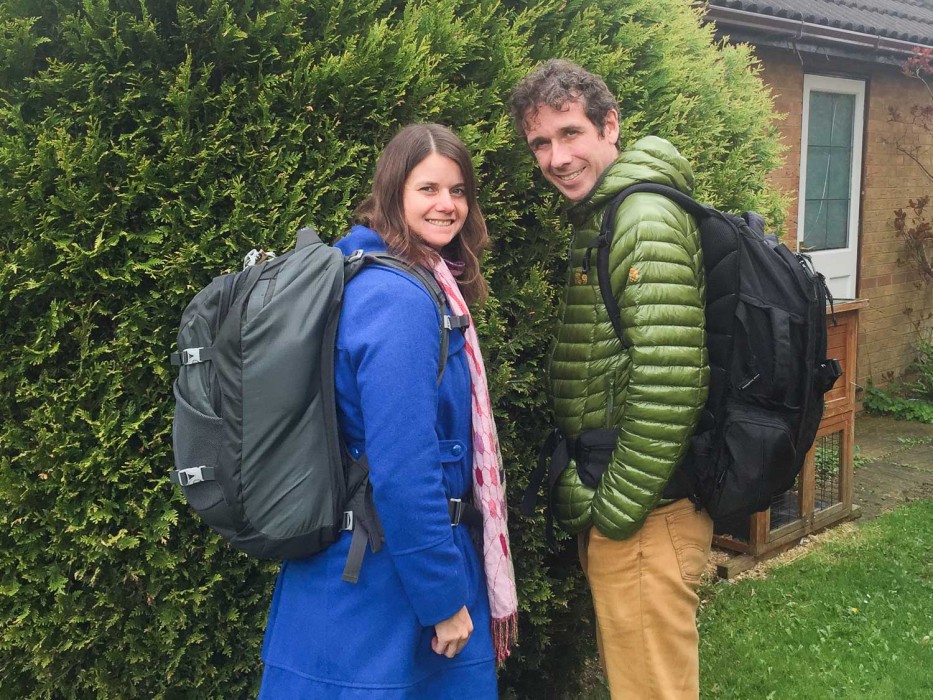
We’ve found that most airlines aren’t too strict about the exact size of carry on luggage.
In over 12 years we’ve never had our bags measured, although our luggage has been a little over the size restrictions of some airlines such as Ryanair.
It has helped that for most of that time we’ve travelled with backpacks, which are less likely to draw the attention of airline staff than suitcases.
It’s best to try to board the plane as early as possible as space in the overhead bins can run out, and some budget airlines (like Ryanair and Easyjet) don’t guarantee that there will be space for your cabin luggage even if you meet the restrictions.
We’ve never had an issue with this, but if you are worried, you might want to pay extra for priority boarding, which many budget airlines offer.
We do find this worth the upgrade as it reduces stress about whether your bag will make it on or not, plus there’s less waiting to get on the plane.
Recommended Carry-On Luggage
To be sure you can take your bag on the plane, it’s best to choose luggage that fits the restrictions of the airlines you’ll be travelling on. See the list of allowed sizes at the end of this post.
Backpack
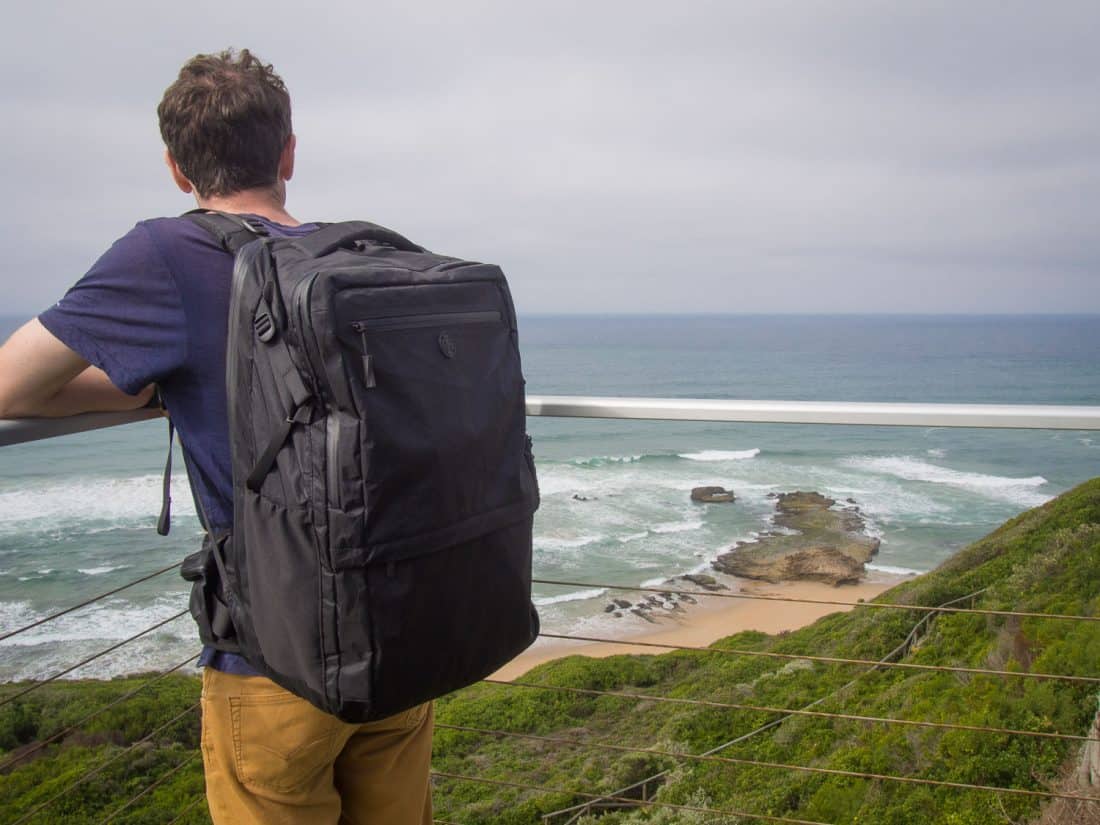
If you’ll be travelling with a backpack, look for one in the range of 30 to 45 litres, but do check the dimensions as well, and be aware that overpacking can make the backpack expand over the stated measurements.
We recommend the Tortuga Outbreaker 45L backpack if you’re looking for the maximum airline carry on size or the Osprey Farpoint 40 for something a bit smaller for stricter airlines.
See our Tortuga Outbreaker Backpack review for more details.
Suitcase
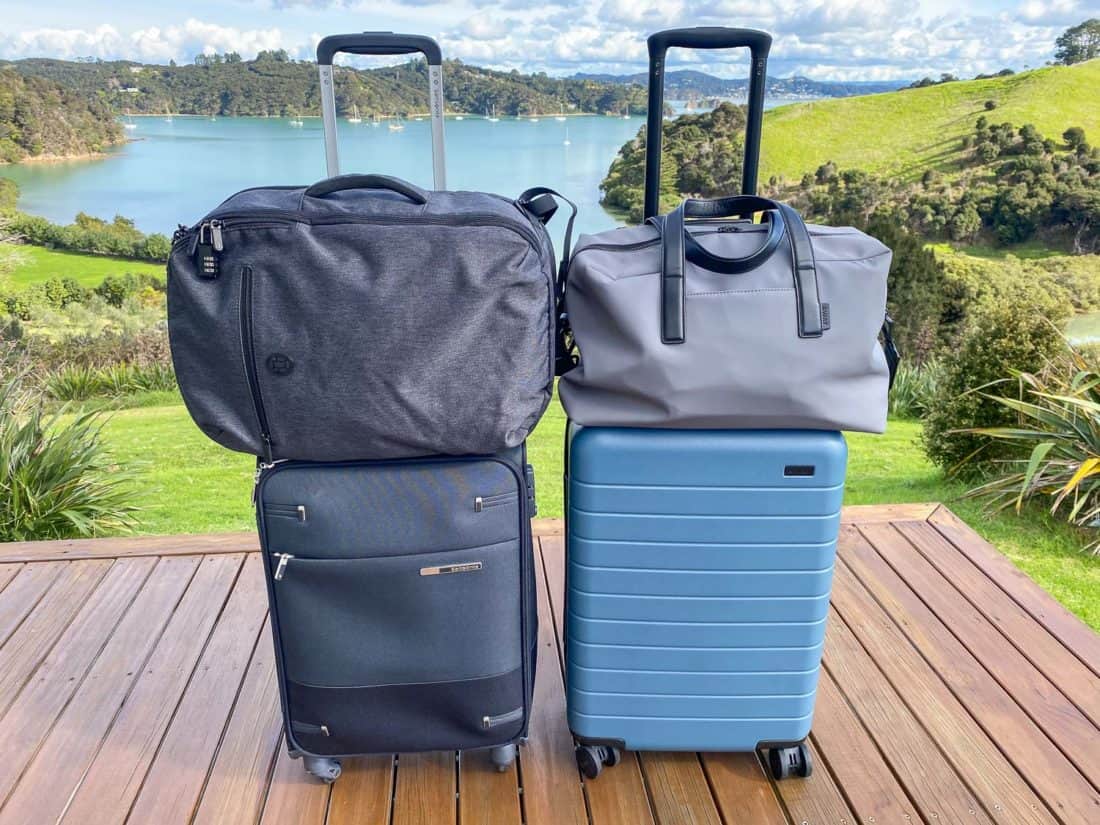
After nearly a decade of travel with backpacks, we switched to carry on size suitcases.
We both have the Away Bigger Carry-On which is technically larger than most airlines allow (at 22.7 x 14.7 x 9.6 inches), but it was designed to fit in the sizers of most US airlines (which are actually a little larger than they say).
This is the best option if you want to maximise the amount so you can take on the plane, but there is a chance you’ll be asked to check it in.
We haven’t had any problems so far travelling on international long-haul flights and budget airlines in Europe including these:
- Easyjet
- Ryanair
- Wizz Air
- Norwegian Air
- British Airways
- American Airlines
- Singapore Airlines
- Air New Zealand
- Virgin Atlantic
- Virgin Australia
- Hawaiian Airlines (Interisland as well as from mainland USA)
- Japan Airlines
If you are worried the Away Bigger Carry-On will be denied boarding, a smaller, safer option is the Away Carry-On. This measures 21.7 x 13.7 x 9 inches and is designed to meet the carry on requirements for as many airlines as possible.
Carry On Luggage Weight Limit
How much can a carry on bag weigh?
While US domestic airlines don’t usually have carry on bag weight limits, the rest of the world does. Cabin luggage usually has a weight restriction from 5 kg to 12 kg, with most airlines in Asia and Australia limiting it to 7 kg.
This is a big concern for many people, as by the time you’ve added up the weight of your bag and perhaps a laptop, it doesn’t leave much for other things.
The weight of our luggage varies, but it is usually over the limits for the airlines we fly.
Do airlines weigh carry on bags?
In over 12 years of full-time travel, our carry-ons have only been weighed twice. Most of the time we find that airlines don’t bother, but that’s partly because we follow the tips below.
We aim not to draw attention to ourselves—if the bag doesn’t look big and heavy then the airline is less likely to weigh it.
It was easier when we travelled with a backpack rather than a suitcase, which is more conspicuous and looks heavier. Backpacks also tend to use up less of your weight limit than heavier suitcases. But we have managed it with our Away carry-ons.
There are a few things you can do to help reduce the weight of your luggage and avoid getting it weighed at the airport:
Check-in online – Print your boarding pass in advance (we ask our hotel) or save it to your phone if the airline allows it, so you can avoid the check-in desk and go straight to security. The check-in desk is where your bag is most likely to be weighed.
Use your personal item – If you have to use the check-in desk and the airline allows an extra personal item (see below for details), remove something heavy from your bag like a laptop, camera, or packing cube while you are checking in. You can always put it back in your bag afterwards.
You could also do this if you get weighed at the gate—there’s no need to check your luggage if you haven’t maximised your personal item allowance. Most airlines don’t include your personal item in the weight limit but a few do, so always check before you fly.
Wear it – Wear your heaviest clothes and shoes on the plane—we did this for a ski trip to Finland. If it’s too warm to wear your jumper or jacket, carry it or tie it around your waist rather than pack it.
Compress – Be careful how you pack your bag so it doesn’t look too bulky. Use packing cubes or compression bags to reduce the size of your clothes and compress the straps on the outside of your backpack to make it smaller. If it doesn’t look big, the airline is less likely to weigh it.
One bag – If you travel with just one bag you’ll be less conspicuous—the aim is not to draw attention to yourself. The airline is more likely to weigh the bags of people who look loaded down with luggage.
Fill your pockets – If the airline is really strict you could fill your pockets with some of your heavier items—cargo pants or a jacket with pockets would be ideal. We’ve never had to do this but Benny Lewis managed to carry on 15 kg of gear in his jacket!
Beg! – One time when our backpacks were weighed while checking-in for a domestic flight in Thailand, they were found to be overweight. We politely explained to the staff member that we couldn’t check our bags as they were full of laptops and cameras. They let us take them with us, with a warning that we might be stopped at the gate (we weren’t). It’s always worth asking (nicely, of course).
The worst-case scenario is that your bag gets weighed and you’re forced to check it in. Have a backup plan for this situation if you don’t already have a second personal item.
The only time we’ve had to check our luggage was on a tiny seaplane in the Maldives. When that happened we moved our valuables (laptops and camera) to our packable daypack and tote bag that we had in our main bags and used those as our carry-on luggage (this was before we started travelling with two items of luggage).
Don’t let the weight issue stop you travelling with a carry-on. Try to keep the weight down, apply some of the above tips, and remember that if you do end up having to check it in, it’s unlikely to happen on every flight, and it’s still better than checking your luggage all the time.
Note: One airline that does regularly weigh hand luggage at the gate is Jetstar in Australia and Asia. They only allow 7 kg combined weight for your cabin bag and personal item and will charge you AUD $50-160 to check in over the limit bags at the gate. We travelled with them on a domestic flight in Vietnam without a problem though.
Additional Personal Item
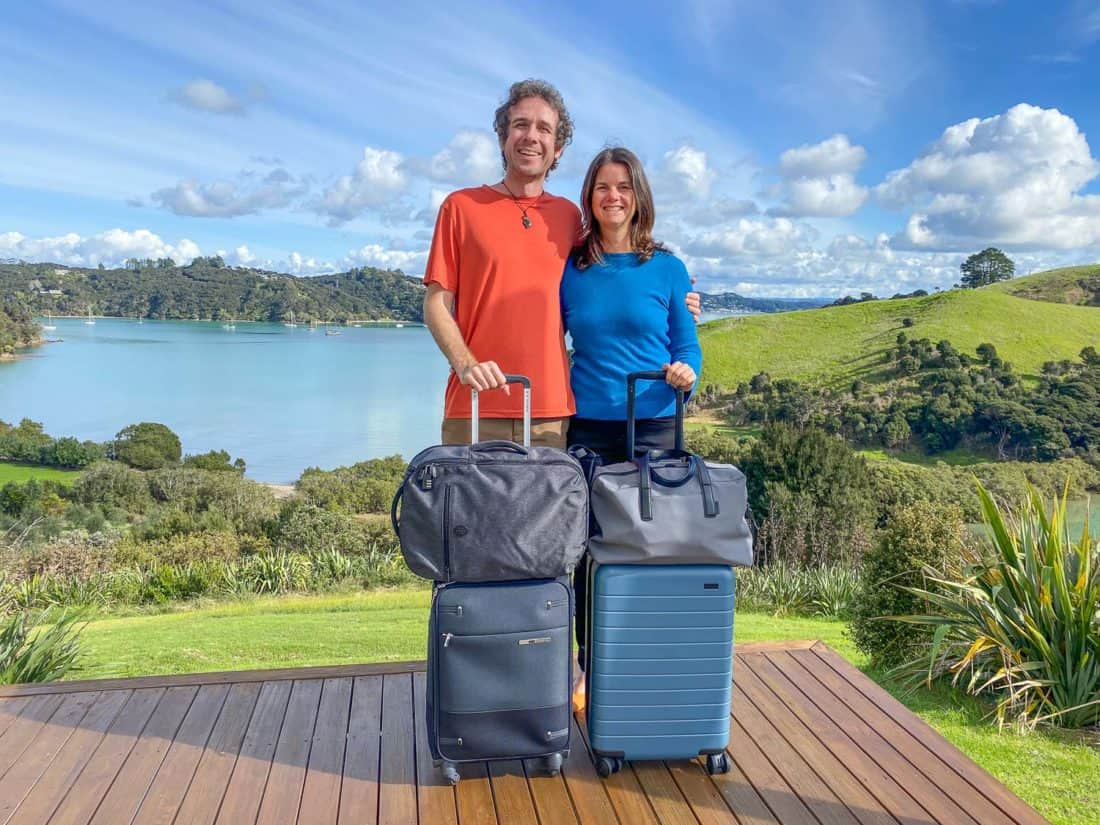
Most airlines allow one piece of carry-on luggage plus an additional personal item which must fit under the seat in front of you.
Some airlines allow any small bag including a backpack, handbag, laptop case, or shoulder bag, while others only allow a small purse or handbag. Check with the airline you’ll be travelling with for the size and weight restrictions on personal items.
A few airlines don’t allow personal items, so we used to manage without a second bag. Instead, we used a packable backpack as a day bag that we packed inside Simon’s backpack when needed and took out when a personal item was allowed (our current favourite is the Matador Freefly 16).
We now travel with a suitcase plus personal item each—see our carry on packing list for details of why we changed.
For our personal items, I have the Away Everywhere Bag and Simon has the Tortuga Setout Laptop Bag (no longer available but the Tortuga Outbreaker Laptop Bag is similar).
They both have sleeves that pass through our suitcase handles so we don’t need to carry them—this makes airports so easy.
In addition to your carry-on and personal item, some airlines allow extra articles such as a jacket, umbrella, small bag of food, and bag of duty-free items. Check with the airline as allowances vary. If weight is a concern carry rather than pack these things.
List of Airline Carry On Luggage Size and Weight Allowances
These are the carry on luggage dimensions and weights allowed for your main piece of cabin baggage on major airlines.
A smaller personal item is also allowed unless I’ve stated otherwise—check with the airline for the size.
These are the allowances for flying economy. Extra bags may be allowed if flying premium economy, business, or first class.
Luggage rules do change, so check the airline’s website before you fly.
North America
US airlines have the most generous carry-on bag size allowances, often with no weight limit.
There is no TSA carry on size—the luggage allowances are set by each airline.
Aeromexico: 21.5 x 15.7 x 10 inches (55 x 40 x 25 cm), 22 lb (10 kg) Basic Rate, 33 Ib (15 kg) Classic Rate, AM Plus, and Premier on domestic flights.
Air Canada: 21.5 x 15.5 x 9 inches (55 x 40 x 23 cm), no weight limit.
Alaska Airlines: 22 x 14 x 9 inches (56 x 36 x 23 cm), no weight limit.
American Airlines: 22 x 14 x 9 inches (56 x 36 x 23 cm), no weight limit.
Delta: 22 x 14 x 9 inches (56 x 36 x 23 cm), no weight limit.
JetBlue Airways: 22 x 14 x 9 inches (56 x 36 x 23 cm), no weight limit.
Southwest Airlines: 24 x 16 x 10 inches (61 x 41 x 25 cm), no weight limit.
Spirit Airlines: 22 x 18 x 10 inches (56 x 46 x 25 cm). No weight limit.
United: 22 x 14 x 9 inches (56 x 36 x 23 cm), no weight limit. If you travel on a Basic Economy ticket domestically, you can only take a personal item or pay $25 for a large carry-on.
Volaris: If you travel Zero only one personal item that fits underneath a seat is allowed, pay between $47-55 for additional carry-on. The Basic option allows one personal item and carry-on of 22 x 16 x 10 inches (56 x 41 x 25 cm), maximum weight with all items 44lb (10kg).
Europe
European airlines tend to be stricter than US airlines, especially about luggage weight and personal items (which are sometimes not allowed). Avoid getting your bag weighed if possible (see the tips above).
Air France: 55 x 35 x 25 cm (22 x 14 x 10 inches), 12 kg (26 lb).
British Airways: 56 x 45 x 25 cm (22 x 18 x 10 inches), 23 kg (51 lb).
EasyJet: 45 x 36 x 20cm (18 x 14 x 8 inches), 15 kg (33 lb). If you book an Up Front or Extra Legroom seat, or pay to add a large cabin bag, you get an additional item 56 x 45 x 25 cm (22 x 18 x 10 inches), 15 kg (33 lb).
Jet2: 56 x 45 x 25 cm (22 x 18 x 10 inches), 10 kg (22 lb).
KLM: 55 x 35 x 25 cm (22 x 14 x 10 inches), 12 kg (26 lb).
Lufthansa: 55 x 40 x 23 cm (22 x 16 x 9 inches), 8 kg (18 lb).
Norwegian: LowFare tickets allow only one underseat bag of 30 x 20 x 38cm (12 x 8 x 15 inches), 10 kg (22lb) for free. LowFare+ allows an additional overhead cabin bag of 55 x 40 x 23cm (22 x 16 x 9 inches), both bags combined up to 10 kg (22 lb). Flex allows up a combined weight limit up to 15 kg (33 lb).
Ryanair: Only small bags of 40 x 20 x 25 cm (16 x 8 x 10 inches) are allowed for free. You must pay extra to take a large bag of 55 x 40 x 20 cm (22 x 16 x 8 inches) weighing up to 10 kg (22 lb), which includes priority boarding.
Scandinavian Airlines: 55 x 40 x 23 cm (22 x 16 x 9 inches), 8 kg (18 lb).
Turkish Airlines: Usually 55 x 40 x 23 cm (22 x 16 x 9 inches), 8 kg (18 lb).
Virgin Atlantic: 56 x 36 x 23 cm (22 x 14 x 9 inches), 10 kg (22 lb).
Asia
The weight restrictions on airlines in Asia are even stricter than in Europe.
Air Asia: 56 x 36 x 23 cm (22 x 14 x 9 inches), 7 kg (15 lb).
Air China: 55 x 40 x 20 cm (22 x 16 x 8 inches), 5 kg (11 lb).
Air India: 55 x 35 x 25 cm (22 x 14 x 10 inches), 8 kg (18 lb).
Cathay Pacific: 56 x 36 x 23 cm (22 x 14 x 9 inches), 7 kg (15 lb).
Emirates: 55 x 38 x 20 cm (22 x 15 x 8 inches), 7 kg (15 lb). No personal item.
Japan Airlines: 55 x 40 x 25 cm (22 x 16 x 10 inches), 10 kg (22 lb).
Lion Air: 40 x 30 x 20 cm (16 x 12 x 8 inches), 7 kg (15 lb). No personal item except a small purse or camera.
Qatar Airways: 50 x 37 x 25 cm (20 x 15 x 10 inches), 7 kg (15 lb). No personal item except a small purse, briefcase, or camera.
Singapore Airlines: Sum of length, width and height of each piece should not exceed 115cm (45 inches), 7 kg (15 lb).
Thai Airways: 56 x 45 x 25 cm (22 x 18 x 10 inches), 7 kg (15 lb).
Tigerair (Asia): 54 x 38 x 23 cm (21 x 15 x 9 inches), 10 kg (22 lb) including personal item.
Oceania
As in Asia, weight limits are low.
Air New Zealand: Not exceeding total linear dimensions (length + width + height) of 118 cm (46.5 inches), 7 kg (15 lb).
Jetstar: 56 x 36 x 23 cm (22 x 14 x 9 inches), 7 kg (15 lb). They regularly weigh hand luggage at the gate and charge high fees to check in overweight bags. You can pay extra for a 14kg (30 lb) allowance.
Qantas: 56 x 36 x 23 cm (22 x 14 x 9 inches), 7 kg (15 lb).
Virgin Australia: 56 x 36 x 23 cm (22 x 14 x 9 inches), 7 kg (15 lb).
More Posts on Travelling Carry-On Only
Check out our other posts about packing light:
- Our Carry-On Packing List (Updated)
- Carry-On Travel in 10 Easy Steps
- Allbirds Review: The Best Travel Shoes
- How to Pack Carry-On Only For Cold Weather
- Ski Trip Packing List
If you enjoyed this post, pin it!
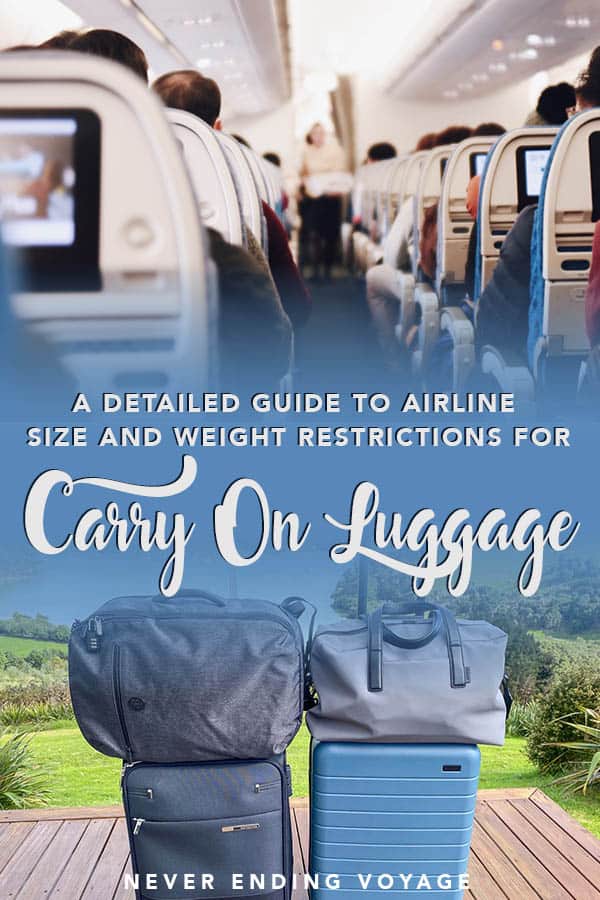
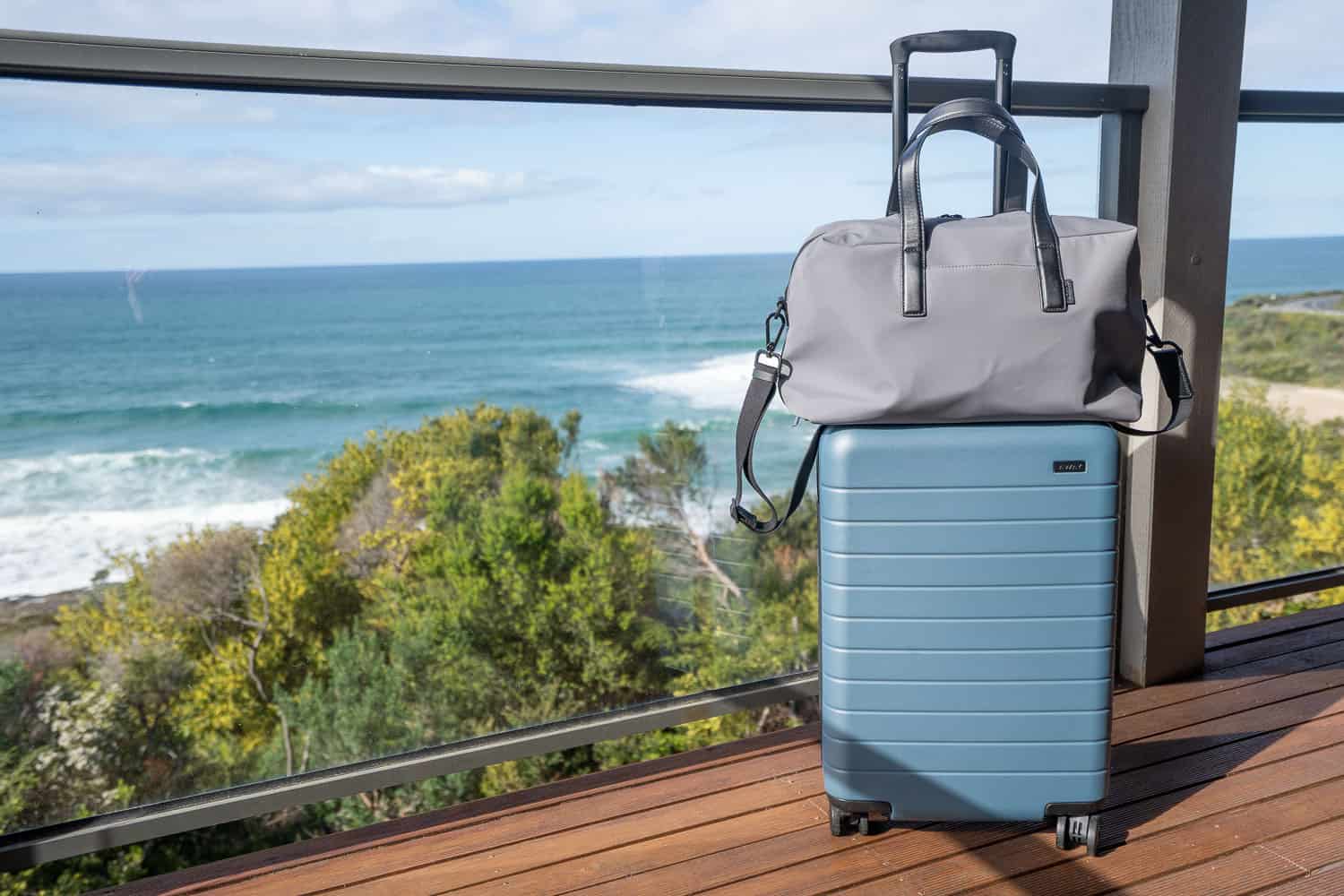
Hi. I’ve been. looking at the Away Bigger Carry On and use my Away BackPack as a daily bag for work. My concern was that we regularly fly Wirth Virgin Atlantic. Can I ask how many times you’ve used the Bigger Carry On as an actual carry on with Virgin?
We’ve only flown Virgin Atlantic once since we’ve had the Bigger Carry On. We haven’t had an issue on any airlines we’ve travelled with it on though (including budget airlines, which are the ones that are most likely to be an issue).
Thanks. The Bigger Carry On is 0.6” and 0.7” bigger and I imagine the handles on the top and side almost account for that. It’s also 40% off at the minute so I was thinking of getting myself and my wife one for our upcoming holidays!
Hi Erin!
I love your website, especially the packing section! Thank you for all the incredibly specific and helpful information! I just have a quick question if you don’t mind…. What size Away Everywhere Bag do you use, the medium or large?
You guys are the best!
Liz
Thanks, Liz! I use the medium and it fits on top of the suitcase and under a plane seat perfectly.
Hi! I’m looking to travel with an Away Bigger Carry On and the Away Everywhere Bag on Air Canada — have you had any issues with them with those Away items? Thanks for any feedback on it :)
That’s what I travel with. I haven’t travelled on Air Canada but I’ve travelled on many airlines (listed in this post) with no problems.
Hello! I’ll be going to Europe next soon & I’ll be going on like 8 different flights in Europe. For example, one airline is AirFrance & my carry on bag (filled w clothes) seems to fit the criteria. But do you know if I’m allowed to bring a backpack? So I can put my wallet & personal things in there? I know it’s a broad question but I just wanted to see if knew any more info on that (backpack AND a carry on bag that I can physically carry. Not the ones w wheels) Also, I read your whole post & I was just wondering if you think those measurements are also okay for the trains there? I’m taking the train from the airport (Spain) to a city & it’s like 4 hours. But in your travel experience, have you had any issues with trains in Europe? Sorry for the long comment. I loved your post & everything was so informative! Thank you !
Air France allows one carry on bag and one personal item, so you’ll be fine taking a small backpack as well. It just needs to fit under the seat in front of you (the larger bag can go overhead).
I think you’ll be fine on the trains. There will be people with much bigger suitcases, and if yours doesn’t fit above your seat, there are luggage racks at the end of each carriage.
Have a great trip!
Anxious to hear how the Away bag worked on your flights to Europe! Please keep use posted. I was considering the Away Bigger Carry On for a flight to France this September. Thanks!
We were totally fine on an Easyjet flight from London to Greece last month! They actually have a feature on their app where you can check the bag fits the sizers and it does! We will update the post once we’ve taken more European flights (we have one on Wizzair next week).
Any additional updates on the use of the Away Bigger Carry On in Europe this summer?
We’ve had no problems taking it on any airlines including Ryanair and Easyjet. We did check in online though.
Hello Erin, I was researching how strict KLM is with the luggage dimensions and found your blog. I will be traveling to Europe for three weeks this Sept and I wonder if you know the Away’s Bigger Carry On will fit on the plane. One check-in luggage costs $75 for KLM and I would like to avoid the fee. Thank you!
Technically the Bigger Carry On is over the allowed carry-on size for KLM. I don’t know how strict they are – sometimes you can get away with a bigger bag but if you want to be sure, the smaller Away Carry On is within their allowed size of 55 x 35 x 25 cm (21,5 x 13,5 x 10 inch).
Someone on the Tom Bihn forum has started a website called Bags VS Airlines. It’s a hobby project that they work on as they have time, but the goal is to have a comprehensive drop down menu for most carry on bags and most airlines so that you can check if your bag will fit in the sizer bin no matter who you are flying with.
That’s handy! Although our personal experience is that we’ve been able to take bags on as carry on luggage that we technically shouldn’t have been able to according to the tool.
Absolutely! The luggage regulations are rarely enforced, and when they are they usually apply more to wheeled bags that can’t squish into the overhead bins on an airplane.
This website is a great tool for someone travelling for the first time and feeling pretty stressed about all the different regulations to be aware of. It’s also a good comparison for airlines from different countries, since I’m from Canada and some of the local airlines have huge luggage allowances compared to budget airlines overseas.
Great write-up folks… :)
Really helps..
I am just in the process of buying either Osprey 40 or Tortuga backpack. I want to have “universal” carry on backpack, which should also fit new Ryanair restrictions (40x25x20 cm). By fitting I mean that the backpack can be half packed and squeezed to that size.
The biggest problem with Osprey I see, is that it has a metal wire around the frame and I think you cannot squeeze ist height not even for a centimeter. The Ryanair allowance might be a bit overkill, but could you guys please report what are the minimum dimensions of both backpacks that they can be squeezed too?
You’re right. The frame on the Osprey means the height can’t be reduced at all so it wouldn’t fit those dimensions. I would just pay the £6 for priority boarding (which we find makes flying less stressful anyway) and be able to take a larger bag on board. The new Ryanair rule means you can only take a very small backpack on that will fit under your seat.
Question: when you reach your destination and want to head to a workspace or the beach, do you re-use your carry-on bags? or do you carry smaller backpacks as “day packs”? I find the carry-on bags so big and bulky for daily use, they don’t look cool
We have a cotton shoulder bag that packs away inside Simon’s backpack on travel days. If we need something a more robust bag for a long hike or both our laptops, we use my Osprey backpack. There are plenty of packable backpacks that you can use as a day bag, like this one from Sea to Summit: http://amzn.to/1Uam7SF .
It’s good that the IATA paused this Cabin Ok idea because it doesn’t make any sense. Let the airlines decide for themselves what they want to do. Here’s a list of the carry-on limits for most major American airlines which are a bit larger then what the IATA proposed as new carry-on luggage restrictions.
Whatever I do I just can’t make that carry on size for my upcoming 15 month trip. I think if I was just going to a summer climate or just going to a winter climate I could swing it- but having to pack for both makes it extremely difficult.
I have the 52L Osprey Farpoint (I’m the women’s size) and it is seriously just borderline carry on. It’s frustrating because I just can’t trim that little bit of extra space I need for everything. Oh well I still get most of the benefits of packing light (no crappy back or having to be married to your luggage), just not the full benefits of being able to go carry on.
You might find you can get away with it on less strict airlines. It’s always worth a try!
I’ve written a bit about packing for multiple climates here: http://www.neverendingvoyage.com/carry-on-only-packing-list-cold-weather/ but the main thing to consider is not packing winter gear if you won’t need it for months. You can always buy stuff when you get there, which is what we do when we get to really cold places.
Thank you for this. My husband and I are about to finish the first leg of our trip around the world. We have been driving across Mexico. We will be heading to Europe without a car. Because we have had the car, we have been carrying a lot more than we want/can when we switch gears.
Your article is helpful. I have an Osprey Porter 46 and would love to be able to carry everything in one bag plus a handbag for my wallet, passport, etc. How do you deal with clothing for both hot and cold climates? We are photographers, so perhaps trying to do everything in a carry on is a fantasy. I have a DSLR and three lenses, plus laptop, hard drives, power cables, etc. To go in my bag, plus clothes. I have packing compression bags for my clothes, which are a great help, but I am trying to wrap my head around carrying winter and warm weather clothes at the same time.
Also, how do you deal with restocking toiletries? Finding travel sizes isn’t as easy as in the US. So we have gone to buying full-sized bottles of shampoo, deoderants, etc. But those sizes aren’t possible with carry on luggage and airline security restrictions.
Thank you.
We take some basic warm clothes in layers and then buy extras when we go to cold destinations. You can read more about it here: http://www.neverendingvoyage.com/carry-on-only-packing-list-cold-weather/
We start with travel size toiletries and then buy larger ones when we’re in a place for a while and leave them behind or refill small bottles when we fly. We also go solid as much as possible – so solid shampoo bars from Lush and solid deoderant.
Thanks for the tips !! For me this is a big problem i always put a lot of things in my carry- on and i realize that i put things that doesnt need
Yep you are definitely right about Jetstar in Australia being strict. It’s not worth risking it if your bag weighs more than 7kg because it costs a lot more to check it at the gate rather than online in advance. Tiger Air in Australia are the same
It does sound like the one airline we wouldn’t risk it. Why are Australian airlines so strict about this? Most American airlines don’t even have a weight limit.
Emirates is strict as well. They only allow 1 bag in the cabin with a max weight of 7kg. No second bag (handbag) allowed. If I had realized I wouldn’t have booked our return trip with them. No biggie since it’s a return flight with only 1 stop prior to US customs. I plan to just pack a camera bag in my Tortuga and then use that as my carry on and check the Tortuga on the way home. Unless I can manage to keep the Tortuga to 7 Kg :-).
We haven’t flown with Emirates recently but we find that while international airlines like this may have low carry on limits they don’t enforce them. We flew with Singapore Airlines a few months ago and they also have a 7 kg limit, but they didn’t weigh our bags. It’s usually worth a try.